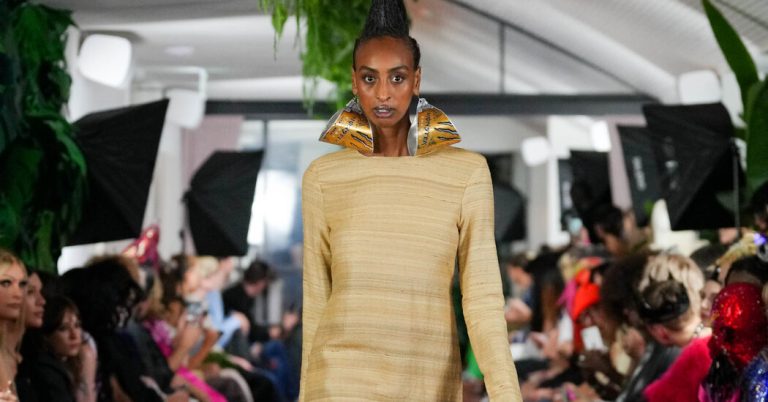The bride in her glamorous wedding attire traditionally appears at the end of a live fashion show, but the finale of Vin + Omi's spring 2024 collection in September during London Fashion Week featured a long-sleeved, floor-length column gown made from giant butterbur vines that grew on Charles III's Sandringham estate.
“It feels amazing, like silk,” said Bin Kara, speaking with Omi Ong over a video call from Spain, where he was filming a documentary about sustainable innovations around the world. “It feels very precious.”
The butterbur fabric is the latest in the duo's ongoing collaboration with the Royal Estate, which has seen them develop 10 new textiles from materials such as nettle and willow cuttings.
None of the nettle fabrics are in commercial production, but a garment made from nettle is in the permanent collection of London's Victoria and Albert Museum. Another is part of the National Museum of Scotland's collection and is on display in Edinburgh until Sunday. The Butterbur dress is currently in storage while its designers decide where to keep it.
The pair met the king, then Prince Charles, at a cocktail reception supporting sustainable fashion in June 2018. “He asked us what we were doing,” says Kara, “and we'd been looking at English country estates at the time” and wondering what was being done with the plant waste there.
“He was really interested,” says Carla, and invited them to collect plants from his organically-grown estate in Highgrove, Gloucestershire. King Charles was a passionate environmentalist and known throughout his life for his concerns about climate change and environmentally-conscious land management.
In recent years, the fashion industry has shown growing interest in alternative sources of material production, such as using mushrooms and pineapple leaves to produce synthetic leather.
“It's accelerating very quickly,” says Claire L'Herpinière, associate professor of sustainable textiles at the School of Fashion and Textiles at De Montfort University in Leicester, U.K. “It's becoming like a real business.”
Though neither had any formal fashion training (Kara had a corporate and sculpting background, while Ong had worked as a photographer and journalist), they had both been troubled by what they had seen as waste in the industry since founding their self-funded label in 2000.
During a visit to Sandringham in February, they noticed that about a quarter of the lake in front of their house was covered in a giant butterbur that needed to be cut back. Native to Asia, the perennial plant, known as Petasites japonicus, grows to about five feet tall with kidney-shaped leaves that can measure up to four feet in diameter.
“It was an ideal place for us to experiment,” says Kara, because the plants need to be pruned and the designers work only with waste materials.
“The fibers of plants with long stems and broad leaves like these are often well suited to being woven into textiles,” he noted.
The two gathered hundreds of leaves, totalling about 6 kilograms (13.2 pounds), and subjected them to a process called retting to extract the long fibers. In the morning, they put the leaves outside to let the dew dampen them, eventually allowing the unwanted parts to rot. The long, thread-like fibers that remained were twisted together using a plant-based binder and made into yarn. A team of six people wove the fabric on handlooms to create a 1.37-meter-wide, 4-meter-long (about 4.5 yards) cloth. The process took about four months.
“It was a classic fabric,” says Kara, who produces classic dresses. Because no chemicals are used, the fabric has a natural golden hue, and the dresses are made with just six seams to limit the amount of energy used in their construction.
Nina Marenzi, founder of Future Fabrics Expo, an annual event in London that showcases sustainable material solutions, said innovations like butterbur fabric are a “great way to communicate what's possible” and that it's important to “shift the collective consciousness so that everyone not only recognises what's possible, but can dream a little more.”

